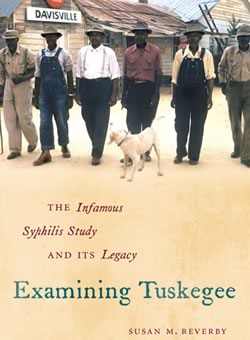 The story of the Study has been told over and
over: in histories, plays, poems, films, jazz, academic articles,
newspaper stories and rumors as an almost inevitable form of exploitation,
a story told in the stereotypes of white power and black victimhood. Examining
Tuskegee: The Infamous Syphilis Study and its Legacy retells
the story of what happened, focusing in on the uncertainties that
almost undermined it that complicate the usually told black and white
tale. It traces the individuals who experienced and perpetuated it and
then explores its nearly forty years in American culture. The Study certainly
happened and through negligence brought illness and death to the
community. Yet the options of what else could have been and why it happened
are now carefully explored.
The story of the Study has been told over and
over: in histories, plays, poems, films, jazz, academic articles,
newspaper stories and rumors as an almost inevitable form of exploitation,
a story told in the stereotypes of white power and black victimhood. Examining
Tuskegee: The Infamous Syphilis Study and its Legacy retells
the story of what happened, focusing in on the uncertainties that
almost undermined it that complicate the usually told black and white
tale. It traces the individuals who experienced and perpetuated it and
then explores its nearly forty years in American culture. The Study certainly
happened and through negligence brought illness and death to the
community. Yet the options of what else could have been and why it happened
are now carefully explored.
Our knowledge of the Study is not just about what happened. It is also about how the story itself is created, which facts are emphasized and what is left out or misremembered. The book is concerned with what becomes the memories, and how the story is told over and over as gospel in multiple communities from the medical schools to the general public where is it is called upon to serve as warning of racism and hubris in research.
Divided into the three parts, the book explores the Testimony, Testifying and Traveling of the Study. The first part examines why the Study began, why it continued, why it was stopped and what happened when its exposure caused widespread outrage. The second part pulls back to ask who was involved in the Study and what happened to them. It uses newly available medical records to explore the disease's affect on the men and their families, and seeks to explain the involvement of representative white doctors and then the major African American physician and nurse who stayed with it for decades. The final section examines how the Study lived on in history and memory and the dangers it poses now for those concerned with health disparities and justice.
View the Table of Contents of this book.


